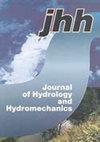格鲁吉亚降水和河水中氧和氢的稳定同位素
IF 2.4
4区 环境科学与生态学
Q3 WATER RESOURCES
引用次数: 0
摘要
摘要本文首次对格鲁吉亚降水和径流的同位素组成进行了综合评价。该研究基于2013年至2022年间收集的11个降水站点的月降水δ18O和δ2H监测数据,以及乔治亚州5个大型集水区的月径流监测数据。这些数据代表了不同的气候和海拔条件,从格鲁吉亚潮湿的西部受黑海影响,到该国干燥的东部可能也受到里海气团的影响。影响降水和河水同位素组成的特殊条件似乎发生在大高加索山脉主山脊附近。我们为佐治亚州确定了国家大气水线(NMWL)和国家河流水线(NRWL),并为各个气象站和河流测量仪确定了当地大气水线(LMWLs)和河流水线(RWLs),并调查了它们的坡度和截距。河流δ18O和δ2H的海拔梯度与降水相似(δ18O和δ2H分别为-0.16‰和-1.2‰/ 100 m)。河流的补给来自一年中较冷的季节(11月/ 12月至3月/ 4月)的降水,而一年中其余较暖的季节降水的同位素组成与河流的同位素组成明显分离。降水中的同位素信号在河流中被抑制了5-6倍。标度线条件过剩量(lc-excess*)并未显示集水区河水与气象条件有任何显著偏差。本文章由计算机程序翻译,如有差异,请以英文原文为准。
Stable isotopes of oxygen and hydrogen in precipitation and river water in Georgia
Abstract The article presents the first comprehensive evaluation of the isotopic composition of precipitation and runoff in Georgia. It is based on data from the monitoring of δ18O and δ2H in monthly precipitation at eleven precipitation stations and monthly runoff from five large, mostly nested catchments in Georgia, collected between the years 2013 and 2022. The data represent different climatic and altitudinal conditions ranging from the wet western part of Georgia affected by the Black Sea to the dry eastern part of the county presumably affected also by the air masses from the Caspian Sea. Specific conditions affecting the isotopic composition of precipitation and river water seem to occur close to the main ridge of the Greater Caucasus Mountains. We defined the National Meteoric Water Line (NMWL) and the National River Water Line (NRWL) for Georgia as well as the Local Meteoric Water Lines (LMWLs) and River Water Lines (RWLs) for individual precipitation stations and river gauges and investigated their slopes and intercepts. Altitude gradients of δ18O and δ2H in the rivers were similar to those in precipitation (–0.16‰ and –1.2‰ per 100 m of altitude for δ18O and δ2H, respectively). The rivers were supplied from precipitation of the colder part of the year (November/December to March/April) while the isotopic composition of precipitation in the remaining warmer part of the year was clearly detached from that of the rivers. The isotopic signal in precipitation was dampened in the rivers by a factor of 5–6. The scaled line-conditioned excess (lc-excess*) did not indicate any significant deviations of river waters from meteorological conditions in the catchments.
求助全文
通过发布文献求助,成功后即可免费获取论文全文。
去求助
来源期刊
CiteScore
4.20
自引率
5.30%
发文量
30
审稿时长
>12 weeks
期刊介绍:
JOURNAL OF HYDROLOGY AND HYDROMECHANICS is an international open access journal for the basic disciplines of water sciences. The scope of hydrology is limited to biohydrology, catchment hydrology and vadose zone hydrology, primarily of temperate zone. The hydromechanics covers theoretical, experimental and computational hydraulics and fluid mechanics in various fields, two- and multiphase flows, including non-Newtonian flow, and new frontiers in hydraulics. The journal is published quarterly in English. The types of contribution include: research and review articles, short communications and technical notes. The articles have been thoroughly peer reviewed by international specialists and promoted to researchers working in the same field.

 求助内容:
求助内容: 应助结果提醒方式:
应助结果提醒方式:


